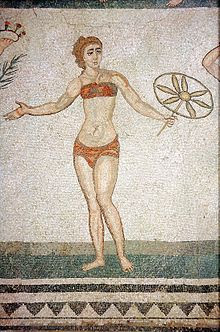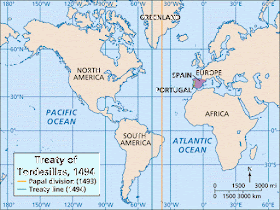 |
Woman in bikini on an ancient Roman mosaic.
|
A bikini is a two-piece swimsuit for women with higher breast bra and pants with cut below the navel, exposing all of her thighs.
 |
The ancient Roman Villa Romana de
Casale (286–305 AD)
in Sicily contains one of the
earliest known illustrations of a bikini.
|
The basic design is simple: two triangles of fabric on the top deck of the breasts of the woman and the two triangles of fabric at the bottom to cover the groin in front and back buttocks. The size of a bikini bottom can vary from complete coverage of the pelvis to a thong or g-string revealing design.
 |
Actress Jane Wyman in beachwear that bares legs and
mid-riff, 1935.
|
The name for bikini design was coined in 1946 by the Parisian engineer Louis Réard, the inventor of the bikini. He named the swimsuit to remember the site Bikini Atoll, where the atomic bomb tests were taking place. Fashion designer Jacques Heim, also in Paris, invented a similar design in the same year. Because of its controversial and revealing design, the bikini was slow to be adopted.
 |
Micheline
Bernardini modeling
Réard's bikini. It was so small it could fit into a small 2 by 2 inches (51 by
51 mm) box like the one she is holding. July 5, 1946.
|
The model Micheline Bernardini was chosen to display the bikini Louis Réard, the July 5, 1946 before a crowd of shocked and amazed spectators.
 |
By 1988 the bikini made
up nearly 20% of swimsuit sales, though one survey indicates 85% of all bikinis
never touch the water.
|
In many countries it was banned on beaches and public places. The Holy See said the sinful design. While still considered a moral risk, bikini gradually became a part of popular culture when movie stars like Brigitte Bardot, Raquel Welch, Ursula Andress and others began using them on public beaches and in the cinema.
 |
"Itsy Bitsy Teenie Weenie Yellow Polka Dot
Bikini"
|














































